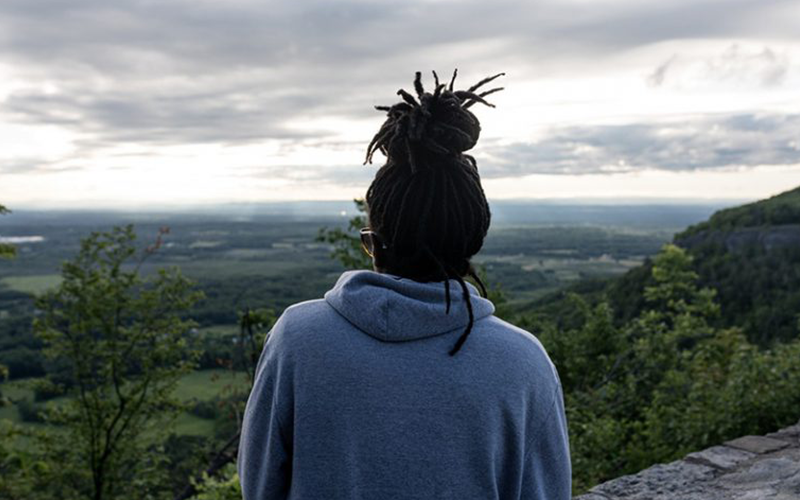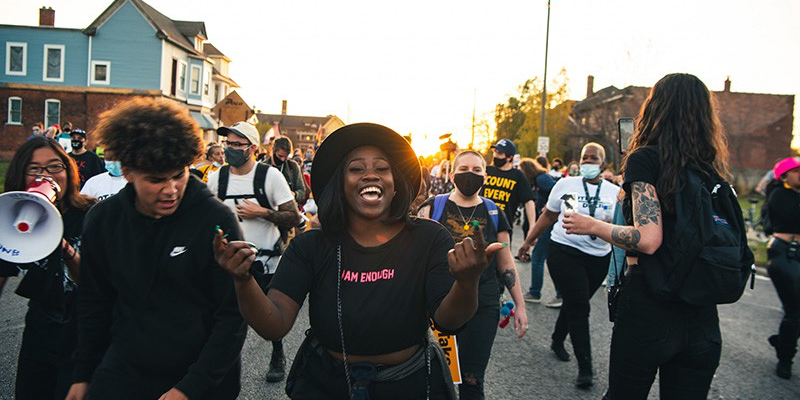Posted by Dr. Gislaine N. Ngounou and Nellie Mae Ed. Fdn.
In a year unlike any other, marked by a global pandemic and persistent racism and violence, we must reckon with what it means to not simply go back to “the way things were.” The way things were was not working for far too many. Our policies, systems, and practices, for the most part, have centered whiteness and white supremacy at the expense and exclusion of the experiences and expertise of Black, Indigenous, Latinx, AAPI, and other communities of color in this nation. We know that many non-profit organizations, communities, and schools — especially those led and staffed by people of color — are often under-resourced, deeply impacted, and overworked. We also know the deep pain and trauma that many have experienced this year. In a grind culture that too often values productivity and capitalism over people and wellbeing, it’s no surprise that so many people are functioning in a constant state of exhaustion.
As funders, let’s step up by not only providing general support to our grantee partners but by thinking about how we can regularly support our partners in accessing healing and rest.
At the Nellie Mae Education Foundation, we’ve seen so many of our grantee partners working around the clock to meet community needs. In Chelsea, Massachusetts, Gladys Vega, Executive Director of La Collaborativa — a community-based organization serving Chelsea residents — spent the majority of the pandemic working 16-hour days. We’ve seen and heard stories of educators who are working at all hours to support students learning remotely, hybrid, and in person. In fact, we’ve even seen many educators departing or considering making the hard decision to leave the profession after impossible and unrealistic expectations have left them feeling devalued, exploited, and exhausted.
“White supremacy is killing us all — in both blatant and subtle ways.”
Even in our sector — philanthropy — we see people working hard to push for sustained change to better support communities most impacted by racial injustices while navigating trauma within entrenched philanthropic structures. Really, we are all exhausted. But this is particularly true of Black, Indigenous, Latinx, and AAPI people invested in liberation and racial justice work. White supremacy is killing us all — in both blatant and subtle ways.
As funders, we must make a commitment to alleviate some of the trauma that our grantees have gone through not just over the past year, but as they do the work and bear the costs we know come with fighting for equity, justice, and freedom. Healing justice is a critical and necessary part of social justice movements. Without it, we will not have the stamina to move forward.
Activist, political strategist, and organizer Charlene Carruthers advocates for adopting healing justice as a core organizing value and practice — reminding us that everyone needs healing because real work for justice and liberation comes with pain and requires intense self-work, self-care, and community care. Additionally, we know that women of color are at the forefront of these movements, and we often pay for it with our lives and our health. This work is non-negotiable for our survival, and it isn’t easy — whether it’s happening in community-based organizations, public education systems, schools, government offices, the health sector, faith-based institutions, philanthropy, or other parts of the ecosystem. But rest and healing is also non-negotiable for us to sustain ourselves in these movements for change.
As Audre Lorde wrote, “Caring for myself is not self-indulgence, it is self-preservation, and that is an act of political warfare.”
At Nellie Mae, we are centering on healing justice as part of our capacity-building program for grantee partners. This past fall, we ran a youth-driven rapid response fund aimed at supporting the mental health of young people, as the pandemic pushed many into remote schooling and separated them from their friends, educators, and networks. Last year, we began a partnership with Getaway and Rachel Cargle, to support opportunities for Black people working for social change — including many educators — to receive a free night of rest away to allow time to recharge and heal. We are aware that these efforts require more resources. We’re organizing time for our staff and community advisors to engage in sessions about healing from racialized trauma, exploring how trauma stemming from racism distorts thinking and sends signals to the body.
“Imagine what a world could look like where healing and rest became a norm, rather than a last straw that we turn to after burnout.”
As a healer, trauma specialist, and psychotherapist Resmaa Menakem reminds us, “we heal primarily in and through the body, not just through the rational brain. We can all create more room, and more opportunities for growth, in our nervous systems. But we do this primarily through what our bodies experience and do — not through what we think or realize or cognitively figure out.” Resmaa advises that our bodies are important parts of the solution and where changing the status quo must begin. They cannot sustain themselves in racial justice and liberation work when they are in pain, exhausted, or constantly harmed by various forms of oppression, overt or subtle.

Photo by @NappyStock
Imagine what a world could look like where healing and rest became a norm, rather than the last straw that we turn to after burnout. Imagine paid therapy and mental health or rest breaks for leaders and staff of nonprofit organizations and educators. It would look like prioritizing rest as a regular part of our lives, as Tricia Hersey teaches through The Nap Ministry. I’ll admit that I, too, am a work in progress. I’m working on being more intentional about incorporating more of these practices in my day-to-day, including dedicated time for meditation and prayer, connecting with nature, extending grace to myself and others, choosing joy, and cultivating a practice that encourages us to take care of ourselves and each other.
“What do communities, organizations, and schools we serve need to be healthy, healed, whole, free, and joyful on their own terms?”
A world where healing and rest are a norm would look like curated affinity spaces for folks that feel safe and affirming, where they can be held and supported — so that they can continue to show up and do the work in healthy ways. It would look like making identity and joy essential dimensions of how teaching and learning unfold in schools, as Gholdy Muhammad advocates for in her Historically Responsive Literacy Framework. It would look like embedding healing in the social and emotional learning of youth, such as the work Dena Simmons leads in guiding educators and communities to do through her work at LiberatED. It would look like philanthropy asking the question: what do the communities, organizations, and schools we serve need to be healthy, healed, whole, free, and joyful on their own terms? Lastly, it would mean making the resources available for the answers to that question to be actualized by those most impacted and closest to the work.
Rest and healing are critical parts of the solution if we are to move closer to a more liberated world in which all people feel sustained, healed, held, safe, loved, and like full, thriving versions of ourselves and society.
Let’s continue this pattern of funding healing justice and rest. General operating support resources are essential so that grantee partners have the flexibility to allocate funds where they think best in their racial justice and liberation work. It is just as important to recognize our individual and collective humanity. Let’s fund grantees’ access and opportunities for healing and rest, and let’s also resource organizations and leaders who provide these supports in culturally responsive ways.
To learn more about healing justice and philanthropy:
Organizations like Decolonizing Wealth, led by Edgar Villanueva, are leading healing summits for professionals of color in philanthropy to heal and engage in community care. Feminist funders like the Astraea Foundation, Groundswell Fund, Third Wave Fund, and Urgent Action Funds have long been doing this work and showing us the way.

